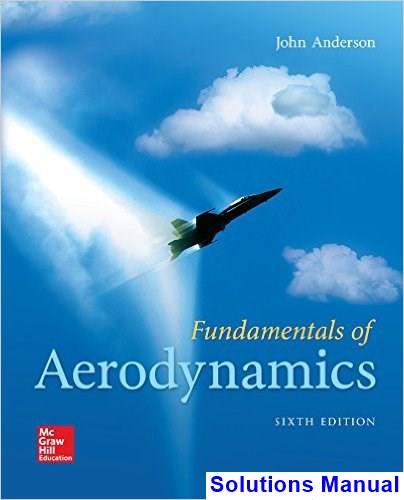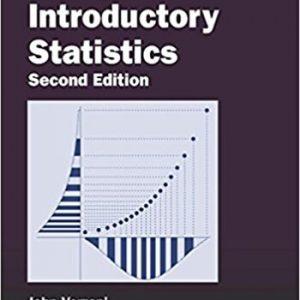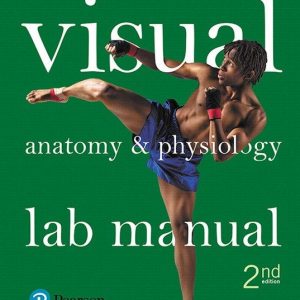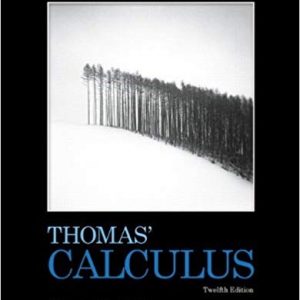This is completed downloadable of Fundamentals of Aerodynamics 6th Edition Anderson Solutions Manual

Product Details:
- ISBN-10 : 1259129918
- ISBN-13 : 978-1259129919
- Author: John D. Anderson
Fundamentals of Aerodynamics is meant to be read. The writing style is intentionally conversational in order to make the book easier to read. The book is designed to talk to the reader; in part to be a self-teaching instrument. Learning objectives have been added to each chapter to reflect what is believed to be the most important items to learn from that particular chapter. This edition emphasizes the rich theoretical and physical background of aerodynamics, and marbles in many historical notes to provide a background as to where the aerodynamic technology comes from. Also, new with this edition, are “Integrated Work Challenges” that pertain to the chapter as a whole, and give the reader the opportunity to integrate the material in that chapter, in order to solve a “bigger picture”.
McGraw-Hill’s Connect, is also available as an optional, add on item. Connect is the only integrated learning system that empowers students by continuously adapting to deliver precisely what they need, when they need it, how they need it, so that class time is more effective. Connect allows the professor to assign homework, quizzes, and tests easily and automatically grades and records the scores of the student’s work. Problems are randomized to prevent sharing of answers an may also have a “multi-step solution” which helps move the students’ learning along if they experience difficulty.
Table of Content:
- PART 1: Fundamental Principles
- Chapter 1: Aerodynamics: Some Introductory Thoughts
- 1.1 Importance of Aerodynamics: Historical Examples
- 1.2 Aerodynamics: Classification and Practical Objectives
- 1.3 Road Map for This Chapter
- 1.4 Some Fundamental Aerodynamic Variables
- 1.4.1 Units
- 1.5 Aerodynamic Forces and Moments
- 1.6 Center of Pressure
- 1.7 Dimensional Analysis: The Buckingham Pi Theorem
- 1.8 Flow Similarity
- 1.9 Fluid Statics: Buoyancy Force
- 1.10 Types of Flow
- 1.10.1 Continuum Versus Free Molecule Flow
- 1.10.2 Inviscid Versus Viscous Flow
- 1.10.3 Incompressible Versus Compressible Flows
- 1.10.4 Mach Number Regimes
- 1.11 Viscous Flow: Introduction to Boundary Layers
- 1.12 Applied Aerodynamics: The Aerodynamic Coefficients—Their Magnitudes and Variations
- 1.13 Historical Note: The Illusive Center of Pressure
- 1.14 Historical Note: Aerodynamic Coefficients
- 1.15 Summary
- 1.16 Integrated Work Challenge: Forward-Facing Axial Aerodynamic Force on an Airfoil— Can It Happe
- 1.17 Problems
- Chapter 2: Aerodynamics: Some Fundamental Principles and Equations
- 2.1 Introduction and Road Map
- 2.2 Review of Vector Relations
- 2.2.1 Some Vector Algebra
- 2.2.2 Typical Orthogonal Coordinate Systems
- 2.2.3 Scalar and Vector Fields
- 2.2.4 Scalar and Vector Products
- 2.2.5 Gradient of a Scalar Field
- 2.2.6 Divergence of a Vector Field
- 2.2.7 Curl of a Vector Field
- 2.2.8 Line Integrals
- 2.2.9 Surface Integrals
- 2.2.10 Volume Integrals
- 2.2.11 Relations Between Line, Surface, and Volume Integrals
- 2.2.12 Summary
- 2.3 Models of the Fluid: Control Volumes and Fluid Elements
- 2.3.1 Finite Control Volume Approach
- 2.3.2 Infinitesimal Fluid Element Approach
- 2.3.3 Molecular Approach
- 2.3.4 Physical Meaning of the Divergence of Velocity
- 2.3.5 Specification of the Flow Field
- 2.4 Continuity Equation
- 2.5 Momentum Equation
- 2.6 An Application of the Momentum Equation: Drag of a Two-Dimensional Body
- 2.6.1 Comment
- 2.7 Energy Equation
- 2.8 Interim Summary
- 2.9 Substantial Derivative
- 2.10 Fundamental Equations in Terms of the Substantial Derivative
- 2.11 Pathlines, Streamlines, and Streaklines of a Flow
- 2.12 Angular Velocity, Vorticity, and Strain
- 2.13 Circulation
- 2.14 Stream Function
- 2.15 Velocity Potential
- 2.16 Relationship Between the Stream Function and Velocity Potential
- 2.17 How Do We Solve the Equations?
- 2.17.1 Theoretical (Analytical) Solutions
- 2.17.2 Numerical Solutions—Computational Fluid Dynamics (CFD)
- 2.17.3 The Bigger Picture
- 2.18 Summary
- 2.19 Problems
- PART 2: Inviscid, Incompressible Flow
- Chapter 3: Fundamentals of Inviscid, Incompressible Flow
- 3.1 Introduction and Road Map
- 3.2 Bernoulli’s Equation
- 3.3 Incompressible Flow in a Duct: The Venturi and Low-Speed Wind Tunnel
- 3.4 Pitot Tube: Measurement of Airspeed
- 3.5 Pressure Coefficient
- 3.6 Condition on Velocity for Incompressible Flow
- 3.7 Governing Equation for Irrotational, Incompressible Flow: Laplace’s Equation
- 3.7.1 Infinity Boundary Conditions
- 3.7.2 Wall Boundary Conditions
- 3.8 Interim Summary
- 3.9 Uniform Flow: Our First Elementary Flow
- 3.10 Source Flow: Our Second Elementary Flow
- 3.11 Combination of a Uniform Flow with a Source and Sink
- 3.12 Doublet Flow: Our Third Elementary Flow
- 3.13 Nonlifting Flow over a Circular Cylinder
- 3.14 Vortex Flow: Our Fourth Elementary Flow
- 3.15 Lifting Flow over a Cylinder
- 3.16 The Kutta-Joukowski Theorem and the Generation of Lift
- 3.17 Nonlifting Flows over Arbitrary Bodies: The Numerical Source Panel Method
- 3.18 Applied Aerodynamics: The Flow over a Circular Cylinder—The Real Case
- 3.19 Historical Note: Bernoulli and Euler—The Origins of Theoretical Fluid Dynamics
- 3.20 Historical Note: D’Alembert and His Paradox
- 3.21 Summary
- 3.22 Integrated Work Challenge: Relation Between Aerodynamic Drag and the Loss of Total Pressure in
- 3.23 Integrated Work Challenge: Conceptual Design of a Subsonic Wind Tunnel
- 3.24 Problems
- Chapter 4: Incompressible Flow over Airfoils
- 4.1 Introduction
- 4.2 Airfoil Nomenclature
- 4.3 Airfoil Characteristics
- 4.4 Philosophy of Theoretical Solutions for Low-Speed Flow over Airfoils: The Vortex Sheet
- 4.5 The Kutta Condition
- 4.5.1 Without Friction Could We Have Lift?
- 4.6 Kelvin’s Circulation Theorem and the Starting Vortex
- 4.7 Classical Thin Airfoil Theory: The Symmetric Airfoil
- 4.8 The Cambered Airfoil
- 4.9 The Aerodynamic Center: Additional Considerations
- 4.10 Lifting Flows over Arbitrary Bodies: The Vortex Panel Numerical Method
- 4.11 Modern Low-Speed Airfoils
- 4.12 Viscous Flow: Airfoil Drag
- 4.12.1 Estimating Skin-Friction Drag: Laminar Flow
- 4.12.2 Estimating Skin-Friction Drag: Turbulent Flow
- 4.12.3 Transition
- 4.12.4 Flow Separation
- 4.12.5 Comment
- 4.13 Applied Aerodynamics: The Flow over an Airfoil—The Real Case
- 4.14 Historical Note: Early Airplane Design and the Role of Airfoil Thickness
- 4.15 Historical Note: Kutta, Joukowski, and the Circulation Theory of Lift
- 4.16 Summary
- 4.17 Integrated Work Challenge: Wall Effects on Measurements Made in Subsonic Wind Tunnels
- 4.18 Problems
- Chapter 5: Incompressible Flow over Finite Wings
- 5.1 Introduction: Downwash and Induced Drag
- 5.2 The Vortex Filament, the Biot-Savart Law, and Helmholtz’s Theorems
- 5.3 Prandtl’s Classical Lifting-Line Theory
- 5.3.1 Elliptical Lift Distribution
- 5.3.2 General Lift Distribution
- 5.3.3 Effect of Aspect Ratio
- 5.3.4 Physical Significance
- 5.4 A Numerical Nonlinear Lifting-Line Method
- 5.5 The Lifting-Surface Theory and the Vortex Lattice Numerical Method
- 5.6 Applied Aerodynamics: The Delta Wing
- 5.7 Historical Note: Lanchester and Prandtl—The Early Development of Finite-Wing Theory
- 5.8 Historical Note: Prandtl—The Man
- 5.9 Summary
- 5.10 Problems
- Chapter 6: Three-Dimensional Incompressible Flow
- 6.1 Introduction
- 6.2 Three-Dimensional Source
- 6.3 Three-Dimensional Doublet
- 6.4 Flow over a Sphere
- 6.4.1 Comment on the Three-Dimensional Relieving Effect
- 6.5 General Three-Dimensional Flows: Panel Techniques
- 6.6 Applied Aerodynamics: The Flow over a Sphere—The Real Case
- 6.7 Applied Aerodynamics: Airplane Lift and Drag
- 6.7.1 Airplane Lift
- 6.7.2 Airplane Drag
- 6.7.3 Application of Computational Fluid Dynamics for the Calculation of Lift and Drag
- 6.8 Summary
- 6.9 Problems
- PART 3: Inviscid, Compressible Flow
- Chapter 7: Compressible Flow: Some Preliminary Aspects
- 7.1 Introduction
- 7.2 A Brief Review of Thermodynamics
- 7.2.1 Perfect Gas
- 7.2.2 Internal Energy and Enthalpy
- 7.2.3 First Law of Thermodynamics
- 7.2.4 Entropy and the Second Law of Thermodynamics
- 7.2.5 Isentropic Relations
- 7.3 Definition of Compressibility
- 7.4 Governing Equations for Inviscid, Compressible Flow
- 7.5 Definition of Total (Stagnation) Conditions
- 7.6 Some Aspects of Supersonic Flow: Shock Waves
- 7.7 Summary
- 7.8 Problems
- Chapter 8: Normal Shock Waves and Related Topics
- 8.1 Introduction
- 8.2 The Basic Normal Shock Equations
- 8.3 Speed of Sound
- 8.3.1 Comments
- 8.4 Special Forms of the Energy Equation
- 8.5 When Is a Flow Compressible?
- 8.6 Calculation of Normal Shock-Wave Properties
- 8.6.1 Comment on the Use of Tables to Solve Compressible Flow Problems
- 8.7 Measurement of Velocity in a Compressible Flow
- 8.7.1 Subsonic Compressible Flow
- 8.7.2 Supersonic Flow
- 8.8 Summary
- 8.9 Problems
- Chapter 9: Oblique Shock and Expansion Waves
- 9.1 Introduction
- 9.2 Oblique Shock Relations
- 9.3 Supersonic Flow over Wedges and Cones
- 9.3.1 A Comment on Supersonic Lift and Drag Coefficients
- 9.4 Shock Interactions and Reflections
- 9.5 Detached Shock Wave in Front of a Blunt Body
- 9.5.1 Comment on the Flow Field Behind a Curved Shock Wave: Entropy Gradients and Vorticity
- 9.6 Prandtl-Meyer Expansion Waves
- 9.7 Shock-Expansion Theory: Applications to Supersonic Airfoils
- 9.8 A Comment on Lift and Drag Coefficients
- 9.9 The X-15 and Its Wedge Tail
- 9.10 Viscous Flow: Shock-Wave/ Boundary-Layer Interaction
- 9.11 Historical Note: Ernst Mach—A Biographical Sketch
- 9.12 Summary
- 9.13 Integrated Work Challenge: Relation Between Supersonic Wave Drag and Entropy Increase—Is Ther
- 9.14 Integrated Work Challenge: The Sonic Boom
- 9.15 Problems
- Chapter 10: Compressible Flow Through Nozzles, Diffusers, and Wind Tunnels
- 10.1 Introduction
- 10.2 Governing Equations for Quasi-One-Dimensional Flow
- 10.3 Nozzle Flows
- 10.3.1 More on Mass Flow
- 10.4 Diffusers
- 10.5 Supersonic Wind Tunnels
- 10.6 Viscous Flow: Shock-Wave/Boundary-Layer Interaction Inside Nozzles
- 10.7 Summary
- 10.8 Integrated Work Challenge: Conceptual Design of a Supersonic Wind Tunnel
- 10.9 Problems
- Chapter 11: Subsonic Compressible Flow over Airfoils: Linear Theory
- 11.1 Introduction
- 11.2 The Velocity Potential Equation
- 11.3 The Linearized Velocity Potential Equation
- 11.4 Prandtl-Glauert Compressibility Correction
- 11.5 Improved Compressibility Corrections
- 11.6 Critical Mach Number
- 11.6.1 A Comment on the Location of Minimum Pressure (Maximum Velocity)
- 11.7 Drag-Divergence Mach Number: The Sound Barrier
- 11.8 The Area Rule
- 11.9 The Supercritical Airfoil
- 11.10 CFD Applications: Transonic Airfoils and Wings
- 11.11 Applied Aerodynamics: The Blended Wing Body
- 11.12 Historical Note: High-SpeedAirfoils—Early Research and Development
- 11.13 Historical Note: The Origin of the Swept-Wing Concept
- 11.14 Historical Note: Richard T.Whitcomb—Architect of the Area Rule and the Supercritical Wing
- 11.15 Summary
- 11.16 Integrated Work Challenge: Transonic Testing by the Wing-Flow Method
- 11.17 Problems
- Chapter 12: Linearized Supersonic Flow
- 12.1 Introduction
- 12.2 Derivation of the Linearized Supersonic Pressure Coefficient Formula
- 12.3 Application to Supersonic Airfoils
- 12.4 Viscous Flow: Supersonic Airfoil Drag
- 12.5 Summary
- 12.6 Problems
- Chapter 13: Introduction to Numerical Techniques for Nonlinear Supersonic Flow
- 13.1 Introduction: Philosophy of Computational Fluid Dynamics
- 13.2 Elements of the Method of Characteristics
- 13.2.1 Internal Points
- 13.2.2 Wall Points
- 13.3 Supersonic Nozzle Design
- 13.4 Elements of Finite-Difference Methods
- 13.4.1 Predictor Step
- 13.4.2 Corrector Step
- 13.5 The Time-Dependent Technique: Application to Supersonic Blunt Bodies
- 13.5.1 Predictor Step
- 13.5.2 Corrector Step
- 13.6 Flow over Cones
- 13.6.1 Physical Aspects of Conical Flow
- 13.6.2 Quantitative Formulation
- 13.6.3 Numerical Procedure
- 13.6.4 Physical Aspects of Supersonic Flow over Cones
- 13.7 Summary
- 13.8 Problem
- Chapter 14: Elements of Hypersonic Flow
- 14.1 Introduction
- 14.2 Qualitative Aspects of Hypersonic Flow
- 14.3 Newtonian Theory
- 14.4 The Lift and Drag of Wings at Hypersonic Speeds: Newtonian Results for a Flat Plate at Angle of
- 14.4.1 Accuracy Considerations
- 14.5 Hypersonic Shock-Wave Relations and Another Look at Newtonian Theory
- 14.6 Mach Number Independence
- 14.7 Hypersonics and Computational Fluid Dynamics
- 14.8 Hypersonic Viscous Flow: Aerodynamic Heating
- 14.8.1 Aerodynamic Heating and Hypersonic Flow—The Connection
- 14.8.2 Blunt Versus Slender Bodies in Hypersonic Flow
- 14.8.3 Aerodynamic Heating to a Blunt Body
- 14.9 Applied Hypersonic Aerodynamics: Hypersonic Waveriders
- 14.9.1 Viscous-Optimized Waveriders
- 14.10 Summary
- 14.11 Problems
- PART 4: Viscous Flow
- Chapter 15: Introduction to the Fundamental Principles and Equations of Viscous Flow
- 15.1 Introduction
- 15.2 Qualitative Aspects of Viscous Flow
- 15.3 Viscosity and Thermal Conduction
- 15.4 The Navier-Stokes Equations
- 15.5 The Viscous Flow Energy Equation
- 15.6 Similarity Parameters
- 15.7 Solutions of Viscous Flows: A Preliminary Discussion
- 15.8 Summary
- 15.9 Problems
- Chapter 16: A Special Case: Couette Flow
- 16.1 Introduction
- 16.2 Couette Flow: General Discussion
- 16.3 Incompressible (Constant Property) Couette Flow
- 16.3.1 Negligible Viscous Dissipation
- 16.3.2 Equal Wall Temperatures
- 16.3.3 Adiabatic Wall Conditions (Adiabatic Wall Temperature)
- 16.3.4 Recovery Factor
- 16.3.5 Reynolds Analogy
- 16.3.6 Interim Summary
- 16.4 Compressible Couette Flow
- 16.4.1 Shooting Method
- 16.4.2 Time-Dependent Finite-Difference Method
- 16.4.3 Results for Compressible Couette Flow
- 16.4.4 Some Analytical Considerations
- 16.5 Summary
- Chapter 17: Introduction to Boundary Layers
- 17.1 Introduction
- 17.2 Boundary-Layer Properties
- 17.3 The Boundary-Layer Equations
- 17.4 How Do We Solve the Boundary-Layer Equations?
- 17.5 Summary
- Chapter 18: Laminar Boundary Layers
- 18.1 Introduction
- 18.2 Incompressible Flow over a Flat Plate: The Blasius Solution
- 18.3 Compressible Flow over a Flat Plate
- 18.3.1 A Comment on Drag Variation with Velocity
- 18.4 The Reference Temperature Method
- 18.4.1 Recent Advances: The Meador-SmartReference Temperature Method
- 18.5 Stagnation Point Aerodynamic Heating
- 18.6 Boundary Layers over Arbitrary Bodies: Finite-Difference Solution
- 18.6.1 Finite-Difference Method
- 18.7 Summary
- 18.8 Problems
- Chapter 19: Turbulent Boundary Layers
- 19.1 Introduction
- 19.2 Results for Turbulent Boundary Layers on a Flat Plate
- 19.2.1 Reference Temperature Method for Turbulent Flow
- 19.2.2 The Meador-Smart Reference Temperature Method for Turbulent Flow
- 19.2.3 Prediction of Airfoil Drag
- 19.3 Turbulence Modeling
- 19.3.1 The Baldwin-Lomax Model
- 19.4 Final Comments
- 19.5 Summary
- 19.6 Problems
- Chapter 20: Navier-Stokes Solutions: Some Examples
- 20.1 Introduction
- 20.2 The Approach
- 20.3 Examples of Some Solutions
- 20.3.1 Flow over a Rearward-Facing Step
- 20.3.2 Flow over an Airfoil
- 20.3.3 Flow over a Complete Airplane
- 20.3.4 Shock-Wave/Boundary-Layer Interaction
- 20.3.5 Flow over an Airfoil with a Protuberance
- 20.4 The Issue of Accuracy for the Prediction of Skin Friction Drag
- 20.5 Summary
- Appendix A: Isentropic Flow Properties
- Appendix B: Normal Shock Properties
- Appendix C: Prandtl-Meyer Function and Mach Angle
- Appendix D: Standard Atmosphere, SI Units
- Appendix E: Standard Atmosphere, English Engineering Units
- References
- Index
- A
- B
- C
- D
- E
- F
- G
- H
- I
- J
- K
- L
- M
- N
- O
- P
- Q
- R
- S
- T
- U
- V
- W
- X
- Y
- Z





